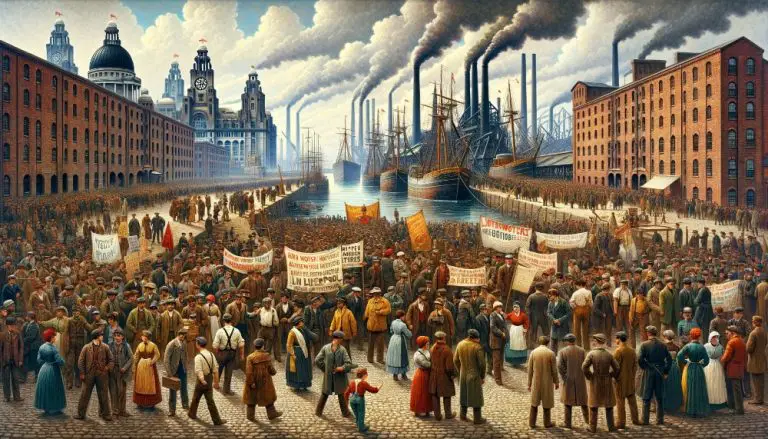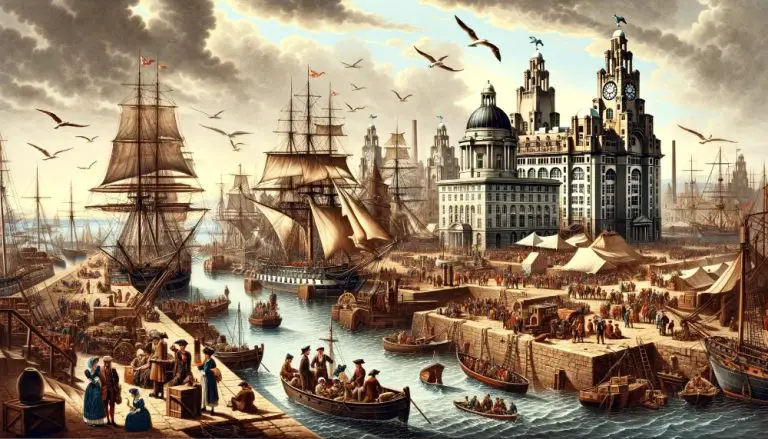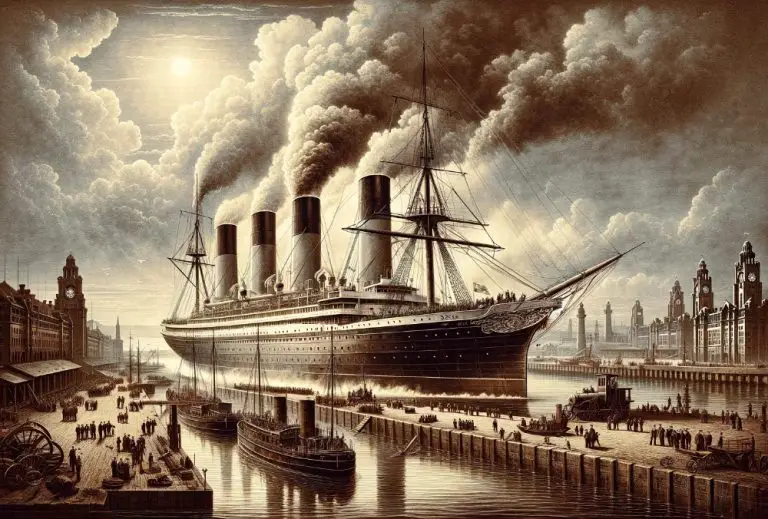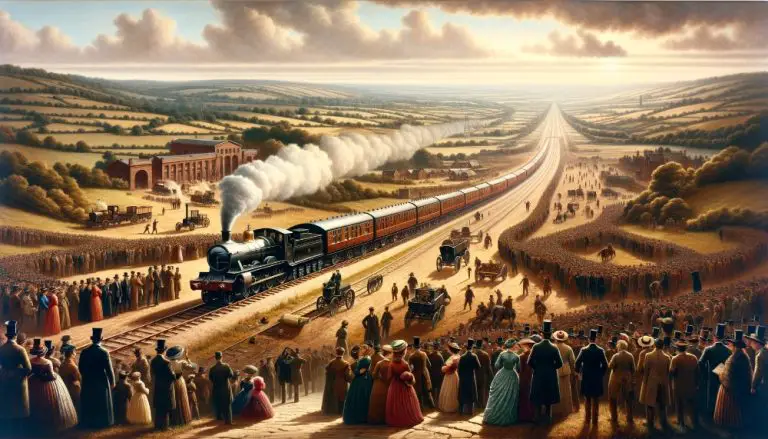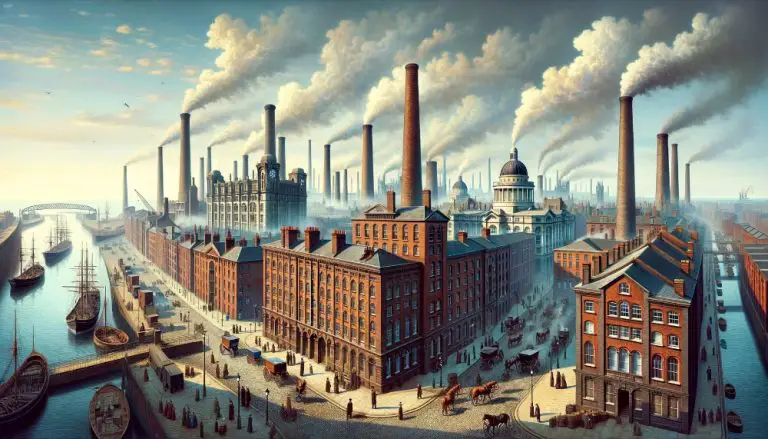The Industrial Growth and Urbanization of Liverpool During the Industrial Revolution
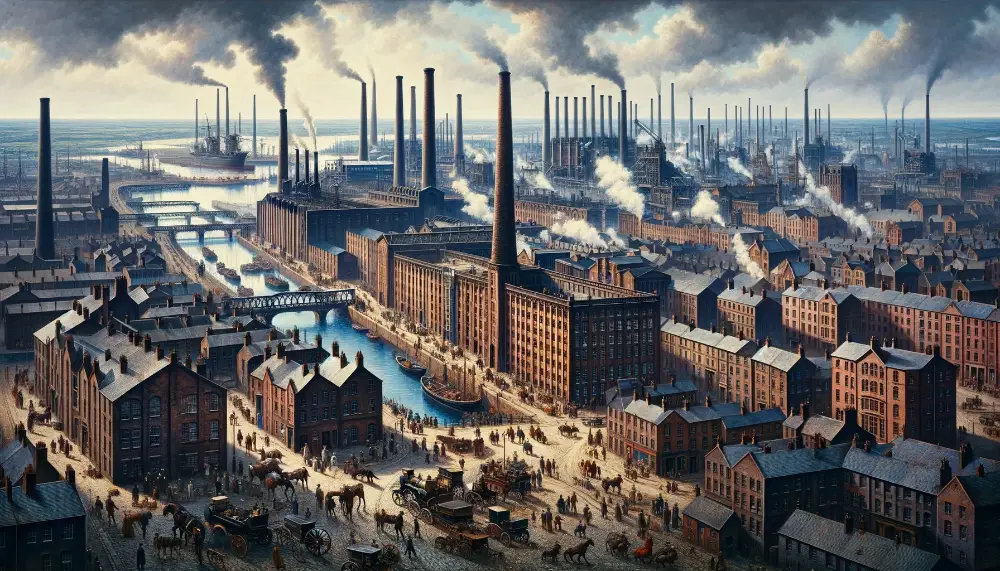
During the Industrial Revolution, Liverpool underwent a remarkable transformation, evolving from a small fishing and farming town into a thriving industrial center. This article explores the industrial growth and urbanization of Liverpool, shedding light on its pivotal role in the development of Britain’s industrial economy.
In the 17th century, Liverpool experienced a surge in prosperity, becoming a crucial trading hub. Its population grew rapidly, propelling it to become Great Britain’s second city. The city played a significant role in the slave trade, with its peak year witnessing the arrival of over 45,000 enslaved individuals from Africa. Liverpool’s prominence continued throughout the Industrial Revolution, as it became the world’s leading city for cotton production. This achievement led to a substantial increase in population and the expansion of urban areas.
Despite the challenges faced during World War II, Liverpool has managed to retain its position as an important cultural and economic center. It is renowned for its infamous gang culture and being the birthplace of The Beatles, further adding to its rich history.
Key Takeaways:
- Liverpool experienced rapid industrial growth during the Industrial Revolution.
- The city played a major role in the slave trade, bringing in thousands of enslaved individuals from Africa.
- Liverpool became the world’s leading city for cotton production.
- Industrialization led to a significant increase in population and urban expansion in Liverpool.
- Despite the impact of World War II, Liverpool remains an important cultural and economic center.
The Impact of Industrialization on Urban Expansion in Liverpool
The process of industrialization in Liverpool during the Industrial Revolution had a profound impact on the city’s urban expansion. With the growth of industries like cotton manufacturing and the slave trade, Liverpool experienced a surge in population, expanding from 6,000 to over 80,000. To accommodate the growing population, infrastructure development played a crucial role.
The city was connected to Manchester by a canal in 1721, allowing for the transportation of goods and raw materials. This canal network facilitated trade and further fueled the city’s industrial growth. In the years following, Liverpool established connections with other places like Leeds and St. Helens, establishing itself as a major trading center.
In 1830, Liverpool achieved another significant milestone by establishing the world’s first inter-city rail link with Manchester. This rail network revolutionized transportation and enabled the movement of goods and people at an unprecedented speed. The rail link opened up new opportunities for industry and trade, contributing to Liverpool’s urban expansion.
“The development of the Canal and Railways has done more to extend the trade and to raise the condition of the people of Liverpool than all the other accidents of the past century.”
The Contributions of Transportation Advancements
The transportation advancements, including the canal and rail network, played a pivotal role in Liverpool’s urban growth. These infrastructure developments allowed for the efficient movement of goods, facilitating the expansion of industries and the establishment of Liverpool as a major industrial center.
The canal network connected Liverpool to various cities and facilitated the import and export of goods. It provided a reliable and cost-effective mode of transportation, boosting trade and industrialization. The canal network also enabled the transportation of raw materials for industries like cotton manufacturing, further fueling Liverpool’s industrial growth.
The establishment of the inter-city rail link with Manchester was a game-changer for Liverpool. It reduced travel time between the two cities, allowing for quick and efficient movement of goods and people. The rail link opened up new markets, creating lucrative business opportunities and attracting more industries to Liverpool.
| Year | Event |
|---|---|
| 1721 | Canal connection with Manchester |
| 1830 | World’s first inter-city rail link with Manchester |
| 1851 | Completion of Albert Dock |
| 1892 | Opening of Liverpool Overhead Railway |
The table above highlights significant transportation milestones in Liverpool’s history. These transportation advancements played a vital role in connecting Liverpool to other cities, expanding trade networks, and driving the city’s urban expansion.
Social and Economic Changes in Liverpool During the Industrial Revolution
The Industrial Revolution brought about significant social and economic changes in Liverpool. As the city experienced rapid urbanization and industrial growth, the economic structure underwent a noticeable shift. There was a decline in agriculture, which had previously been the primary sector, and a rise in manufacturing and services.
Driven by the desire for new employment opportunities, agricultural laborers from rural areas flocked to cities and towns where industries were concentrated, including Liverpool. This influx of population resulted in the formation of diverse communities and contributed to the city’s cultural and social fabric.
The economic prosperity brought by industries like cotton production and the slave trade played a key role in Liverpool’s economic growth. The city became one of the leading industrial centers in the country, attracting investments and creating job opportunities.
“Liverpool thrived during the Industrial Revolution, evolving from a small coastal town to a bustling hub of trade and industry. The influx of people and the growth of industries brought about significant economic changes, transforming the city’s fortunes and shaping its future.”
The social changes during this period were profound. The once predominantly rural and agricultural society gave way to an urbanized and industrialized one. People from different backgrounds and walks of life came together in Liverpool, creating a melting pot of cultures and traditions.
The improved economic conditions and opportunities for employment in Liverpool’s industries fostered a sense of upward mobility for many working-class individuals who relocated to the city. This resulted in a socio-economic transformation, as individuals and families moved away from rural life and embraced the urban lifestyle.
The Industrial Revolution brought both positive and negative social changes to Liverpool. On one hand, it fostered innovation, economic growth, and social mobility. On the other hand, it led to overcrowded living conditions, exploitation of workers, and social inequalities.
In summary, the Industrial Revolution marked a period of significant social and economic changes in Liverpool. The city experienced rapid urbanization, a shift from agriculture to manufacturing and services, and the rise of diverse communities. Economic prosperity brought by industries like cotton production and the slave trade fueled Liverpool’s growth, making it one of the key industrial centers in the country. The social changes, though transformative, also brought about challenges and inequalities.
The Importance of Market Access in Liverpool’s Industrial Growth
Market access played a crucial role in Liverpool’s industrial growth during the Industrial Revolution. The city’s strategic location near the coast provided easy access to national and international markets, making it a prime trading and shipping hub.
The well-developed transportation infrastructure, including canals and railways, further enhanced Liverpool’s market access. These efficient transport networks allowed for the smooth movement of goods, enabling the export of products like cotton and the import of raw materials.
The availability of market access opened up numerous economic opportunities for Liverpool. The city experienced a surge in industrial activities and attracted investors and entrepreneurs seeking to capitalize on its favorable location.
As a result, Liverpool’s industrial growth accelerated, with key industries such as cotton manufacturing flourishing. This growth, driven by the ability to access markets easily, contributed to the city’s economic prosperity and cemented its position as one of the leading industrial centers in Britain.
Market access not only fueled Liverpool’s industrial growth but also had a ripple effect on other sectors. The increased trade and economic activity created jobs, attracted a diverse and vibrant population, and fostered urban development.
To illustrate the significance of market access in Liverpool’s industrial growth, the following table highlights some key trade statistics during the Industrial Revolution:
| Year | Total Value of Exports (£) | Total Value of Imports (£) |
|---|---|---|
| 1750 | 1,523,000 | 822,000 |
| 1800 | 17,361,000 | 11,264,000 |
| 1850 | 69,514,000 | 87,065,000 |
The table demonstrates the significant growth in both exports and imports, indicating Liverpool’s increasing role as a trading powerhouse. Market access enabled Liverpool to connect with global markets, stimulating economic growth and industrial expansion.
Conclusion
The Industrial Revolution had a profound impact on Liverpool, transforming it into a thriving industrial center. The expansion of industries such as cotton manufacturing and the slave trade fueled the city’s industrial growth, leading to a significant increase in population and urban development. Liverpool’s well-connected transportation network, including canals and railways, played a crucial role in its economic prosperity by providing easy access to national and international markets.
Today, Liverpool remains an important cultural and economic center in the United Kingdom. Its industrial heritage, vibrant music scene, and rich history attract visitors from around the world. The city’s transformation during the Industrial Revolution stands as a testament to the power of industrialization in driving urban growth and shaping the destiny of a region.
As we reflect on Liverpool’s journey from a small fishing town to an industrial powerhouse, it is evident that the city’s story is intertwined with the story of industrial growth and urbanization during the Industrial Revolution. Liverpool’s rise to prominence stands as a reminder of the enormous social, economic, and technological changes that shaped the world we live in today.
FAQ
How did industrialization impact Liverpool’s urban expansion during the Industrial Revolution?
With the growth of industries like cotton manufacturing and the slave trade, Liverpool experienced a surge in population, leading to urban expansion. The city’s transportation infrastructure, including canals and railways, played a crucial role in accommodating the growing population and facilitating the movement of goods and people.
What were the social and economic changes that took place in Liverpool during the Industrial Revolution?
The Industrial Revolution brought about significant social and economic changes in Liverpool. The city experienced a shift in its economic structure, with a decline in agriculture and a rise in manufacturing and services. The influx of population seeking employment opportunities in industries led to the creation of diverse communities, contributing to the city’s cultural and social fabric.
How important was market access for Liverpool’s industrial growth?
Market access played a crucial role in Liverpool’s industrial growth. The city’s proximity to the coast and its well-developed transportation infrastructure provided easy access to national and international markets. This made Liverpool a major trading and shipping hub, allowing for the export of goods like cotton and the import of raw materials, which fueled the city’s economic prosperity during the Industrial Revolution.
What were the key factors in Liverpool’s industrial growth and urbanization during the Industrial Revolution?
The expansion of industries such as cotton manufacturing and the slave trade led to significant population growth and urban development in Liverpool. The city’s well-connected transportation network and access to national and international markets were key factors in its industrial growth. These factors allowed Liverpool to become an important industrial center during that time.
What is Liverpool known for today?
Today, Liverpool is known for its rich history, vibrant music scene, and cultural and economic significance. Its transformation during the Industrial Revolution into a thriving industrial center still shines through in its industrial heritage. Liverpool continues to be an important cultural and economic hub, attracting visitors from around the world.
Source Links
- https://www.ncbi.nlm.nih.gov/pmc/articles/PMC2588079/
- https://www.history.co.uk/article/history-of-liverpool
- https://www.campop.geog.cam.ac.uk/research/occupations/outputs/preliminary/marketaccesspresteam.pdf
- The History Behind Liverpool’s You’ll Never Walk Along - February 16, 2024
- The History of Everton FC - February 16, 2024
- The History of Liverpool FC - February 16, 2024

